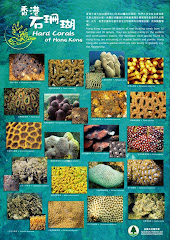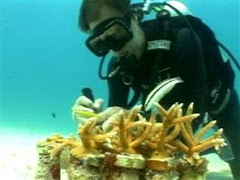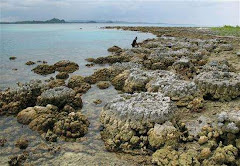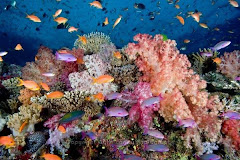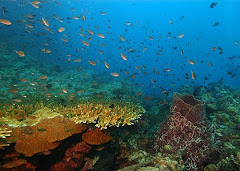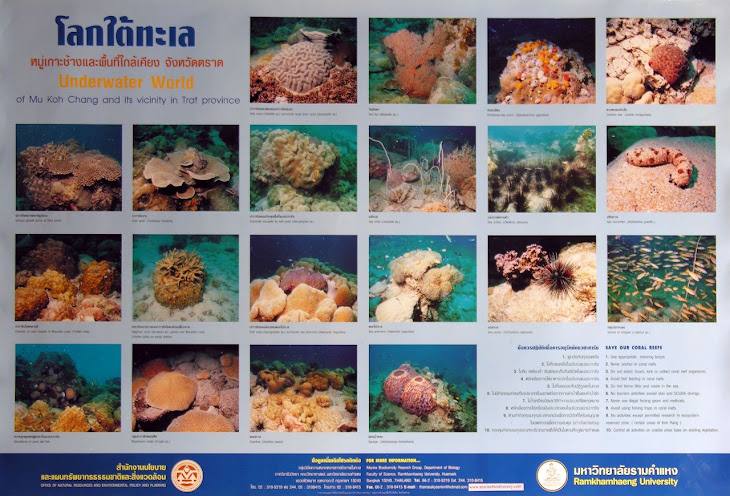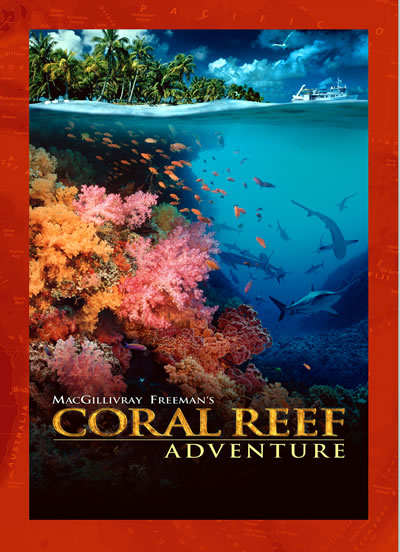Corals are so beautiful,
They're the belles of the sea.
Even though they make nice decorations,
Their not for you and me.
You can take pictures of them,
But cannot take them home.
If you do such a silly thing,
They might feel very alone.
Corals are living things,
They must be treated with care.
Corals belong in their rightful reefs,
Not scattered everywhere.
Corals belong in the ocean,
Don't take them away,
Think about how you'd feel,
If it happens to you one day.
Done by Tabigail Hung
Tuesday, September 9, 2008
Our purpose
Firstly, I would like to thank everybody for visiting our blog project. Our purpose of doing this blog is to create an awareness of the extinction of coral reefs. Before doing this blog, Mei Hui and I did not really understand the true dangers of extinction of coral reefs. Coral reefs are just like plants. They give out oxygen and we need oxygen to survive.
Looking at the current rate of deforestations and cutting down of trees for more land, our future generations may not have sufficient oxygen to live. Then not only plants and animals will become extinct but humans will too. We may not be able to count on trees to provide oxygen for us thus we need corals to pick up their slack.
So please, SAVE EM' CORALS!
Done by Tabigail Hung and Tan Mei Hui
Looking at the current rate of deforestations and cutting down of trees for more land, our future generations may not have sufficient oxygen to live. Then not only plants and animals will become extinct but humans will too. We may not be able to count on trees to provide oxygen for us thus we need corals to pick up their slack.
So please, SAVE EM' CORALS!
Done by Tabigail Hung and Tan Mei Hui
Monday, September 8, 2008
Why do we save corals
Why do we save corals,
It's because we want to live.
Saving corals don't take much time,
It's not a lot to give.
Why do we save corals,
It's because we know it's right
It's really very easy
Just try it if you might.
Done by: Tabigail Hung
It's because we want to live.
Saving corals don't take much time,
It's not a lot to give.
Why do we save corals,
It's because we know it's right
It's really very easy
Just try it if you might.
Done by: Tabigail Hung
Wednesday, August 27, 2008
LET'S SAVE THE REEFS!!!!!!!!
Healthy coral reefs are an important part of a healthy planet. They are just as important to us as plants are on earth. Sea creatures need them to survive, but reefs are helpful to humans as well. The poisons of some reef plants and animals can be used to make medicines. Coral reefs also help to slow down global warming by taking carbon dioxide from the air.
Citizens of many countries will be breaking the law if they drop their anchor on a reef, pollute the water or hunt for coral reefs. You can help save the reefs too! All you have to do is to stop buying shells, corals or saltwater fish. Do do the best you can to save the reefs! I didn't waste all my effort to make this blog you know...
Adapted from live in the coral reefs
Done by Tabigail Hung
Citizens of many countries will be breaking the law if they drop their anchor on a reef, pollute the water or hunt for coral reefs. You can help save the reefs too! All you have to do is to stop buying shells, corals or saltwater fish. Do do the best you can to save the reefs! I didn't waste all my effort to make this blog you know...
Adapted from live in the coral reefs
Done by Tabigail Hung
reefs in danger...big danger! Part 4
Continued from the third part...
Some fish hunters dynamite the reef to stun fish and destroy their hiding places. Others shoot poison or bleach into crevices to drive the fish out. the poisons that they inject often kill many fishes instantly. Those that are captures as pets often die within weeks. Not only are they putting the reefs in danger, they are also cheating us of our money!
Catching many types of reef is against the law. If the situation of taking photos ever happens, they would either decline or mask their faces in case they get arrested or recognised.
adapted from life in the coral reef
Done by Tabigail Hung
Some fish hunters dynamite the reef to stun fish and destroy their hiding places. Others shoot poison or bleach into crevices to drive the fish out. the poisons that they inject often kill many fishes instantly. Those that are captures as pets often die within weeks. Not only are they putting the reefs in danger, they are also cheating us of our money!
Catching many types of reef is against the law. If the situation of taking photos ever happens, they would either decline or mask their faces in case they get arrested or recognised.
adapted from life in the coral reef
Done by Tabigail Hung
reefs in danger...big danger! Part 3
Continued from the second part...
Human carelessness has done a great deal of damage to coral reefs. Many careless divers touch, stand on or kick live corals, killing them. Boaters also kill polyps by dropping their anchors on the corals.
Water pollution makes it impossible for corals to survive in it. Sometimes, boats leak oil or gas into the water. Cans, bags of garbage, plastic bottles and fishing nets are often thrown overboard. Chemicals and sewage are also dumped into the water.
Over-fishing is a threat to the reef community. When people take too many of one kind of fish, They upset the balance of the reef ecosystem. Many of the fish are taken to be sold as pets.
adapted from life in the coral reef
Done by Tabigail Hung
Human carelessness has done a great deal of damage to coral reefs. Many careless divers touch, stand on or kick live corals, killing them. Boaters also kill polyps by dropping their anchors on the corals.
Water pollution makes it impossible for corals to survive in it. Sometimes, boats leak oil or gas into the water. Cans, bags of garbage, plastic bottles and fishing nets are often thrown overboard. Chemicals and sewage are also dumped into the water.
Over-fishing is a threat to the reef community. When people take too many of one kind of fish, They upset the balance of the reef ecosystem. Many of the fish are taken to be sold as pets.
adapted from life in the coral reef
Done by Tabigail Hung
reefs in danger...big danger! Part 2
Continued from the first part...
Coral bleaching happens when polyps lose their zooxanthellae which is the plant that live inside their body.
The polyps turn white and can no longer continue building the reef. Storms and diseases cause some coral bleaching, but scientists think that the greenhouse effect which has turned the temperature up in the seas, caused the damage. Zooxanthellae cannot stay in a polyps body when the water gets too warm.
adapted from life in the coral reef
Done by Tabigail Hung
Coral bleaching happens when polyps lose their zooxanthellae which is the plant that live inside their body.
The polyps turn white and can no longer continue building the reef. Storms and diseases cause some coral bleaching, but scientists think that the greenhouse effect which has turned the temperature up in the seas, caused the damage. Zooxanthellae cannot stay in a polyps body when the water gets too warm.
adapted from life in the coral reef
Done by Tabigail Hung
reefs in danger...big danger! Part 1
Although coral reefs appear to be built of sturdy, solid rock, they are actually very fragile. Storms and coral predators damage reefs, but human carelessness may destroy them completely. That is much worse.
Storm damage can wreck corals that have taken hundreds of years to grow in just a few minutes. Crashing waves smash corals into bits, fling then onto the shore or drag them into deeper waters where they are unable to continue their little lives. How sad...
Too many predators of the coral polyps, such as the crown-of-thorns starfish can devour large areas of coral reefs really fast. They leave only the coral skeletons. Recently, whole reefs have been wiped out because there are just so many of these starfish. You can't call them evil, they're just trying to live. Some scientists think that the number of starfish has grown because people have taken too many of their natural enemies.
adapted from life in the coral reef
Done by Tabigail Hung
Storm damage can wreck corals that have taken hundreds of years to grow in just a few minutes. Crashing waves smash corals into bits, fling then onto the shore or drag them into deeper waters where they are unable to continue their little lives. How sad...
Too many predators of the coral polyps, such as the crown-of-thorns starfish can devour large areas of coral reefs really fast. They leave only the coral skeletons. Recently, whole reefs have been wiped out because there are just so many of these starfish. You can't call them evil, they're just trying to live. Some scientists think that the number of starfish has grown because people have taken too many of their natural enemies.
adapted from life in the coral reef
Done by Tabigail Hung
is this reef crowded or what???!!!
Did you know that coral reefs are actually very crowded? So, in order to survive, each species has its own niche within the reef community. An animals niche includes where it lives on the reef, what it eats, how it finds its food and how it protects itself against predators.
Some reef animals are covered from head to toe with very sharp and painful spines that keep their predators away. Others are either flat or oddly shaped so that they can slip into places which is out of the predators reach. Talk about hide and seek!
Some reef animals live on the reefs surface while some hide in crevices. The rest prefer to be on or near the ocean floor. Creatures that are active at different times often share a home. when one of them is out hunting, it's the others turn to snooze.
adaptedf from life in the coral reef
Daone by Tabigail Hung
Some reef animals are covered from head to toe with very sharp and painful spines that keep their predators away. Others are either flat or oddly shaped so that they can slip into places which is out of the predators reach. Talk about hide and seek!
Some reef animals live on the reefs surface while some hide in crevices. The rest prefer to be on or near the ocean floor. Creatures that are active at different times often share a home. when one of them is out hunting, it's the others turn to snooze.
adaptedf from life in the coral reef
Daone by Tabigail Hung
Wednesday, August 20, 2008
daytime on the reef
Daytime in the reef is as busy and as colourful our daily lives on earth. For us, its car, buses, busy people walking up and down, mothers trying to hush their babies...its the same in the sea, just that instead of all that, we have very busy fishes.
Thousands of fish hunt or graze on sea plants, like corals. Some eacape from enemies or some really hungry prey who hasn't eaten for days...while others defend their area against intruders. Close to two-thirds of reef fish are diurnal otherwise known as active during the day. Turtles and snakes also visit the reef in the daytime.
At the end of the day, the brightly coloured fishes change to slightly duller shades so that it's harder for crespular fish to spot. Crespular fish are fishes that are active in the day and in the night. Talk about 24/7! Some examples of crespular fish are: sharks, barracuda and groupers. As the tired daytime creatures go home for a good nights sleep, they make good and easy target for alert predators. Have a happy feast, dear sharks, barracudas and groupers!
adapted from the coral reef
Done By Tabigail Hung
Thousands of fish hunt or graze on sea plants, like corals. Some eacape from enemies or some really hungry prey who hasn't eaten for days...while others defend their area against intruders. Close to two-thirds of reef fish are diurnal otherwise known as active during the day. Turtles and snakes also visit the reef in the daytime.
At the end of the day, the brightly coloured fishes change to slightly duller shades so that it's harder for crespular fish to spot. Crespular fish are fishes that are active in the day and in the night. Talk about 24/7! Some examples of crespular fish are: sharks, barracuda and groupers. As the tired daytime creatures go home for a good nights sleep, they make good and easy target for alert predators. Have a happy feast, dear sharks, barracudas and groupers!
adapted from the coral reef
Done By Tabigail Hung
Tuesday, August 19, 2008
colours and patterns
A creatures colours or pattern may look beautiful but they are actually very important to its survival. Some markings camouflage animals by helping them to blend into the colourful coral reef. Some creatures, like the octopus, can change their colour to match the different backgrounds that they may be on.
Disruptive patterns, such as stripes, spots and splotches make it difficult for enemies to see the outline of an animal's body. Eyespots confuse their enemies into thinking that their back is their front.
Bright colours may seem pretty on the outside but they may not be what you see. These colours warn predators that certain prey taste really bad or are poisonous. Predators know that creatures with red, black or yellow markings can harm them.
adapted from life in the coral reef
Done by Tabigail Hung
Disruptive patterns, such as stripes, spots and splotches make it difficult for enemies to see the outline of an animal's body. Eyespots confuse their enemies into thinking that their back is their front.
Bright colours may seem pretty on the outside but they may not be what you see. These colours warn predators that certain prey taste really bad or are poisonous. Predators know that creatures with red, black or yellow markings can harm them.
adapted from life in the coral reef
Done by Tabigail Hung
Partnerships between coral reefs and animals
Some animals that live in the reef have partnerships called symbiotic relationships. The partners in a symbiotic relationship provide one another with food, shelter, or protection from enemies. very often, one of the animals cannot live without the other. It's just like us humans and our friends!
One example, is the Clownfish. It always stays near an anemone. Anemones are animals with poisonous tentacles which they use to capture their prey. Unlike other fish, Clownfishes are specially protected from the stinging tentacles. They hide among them to avoid predators. In turn, the Clownfish protect the anemone by fighting off fish that eat it. Everybody wins!
Reefs often have several cleaning stations where cleaner fish or shrimps eat small creatures that live on the scales of larger fish. Cleaner fishes get a meal and help to keep the skin of other fish healthy...another win-win situation!
adapted from life in the coral reef
Done by Tabigail Hung
One example, is the Clownfish. It always stays near an anemone. Anemones are animals with poisonous tentacles which they use to capture their prey. Unlike other fish, Clownfishes are specially protected from the stinging tentacles. They hide among them to avoid predators. In turn, the Clownfish protect the anemone by fighting off fish that eat it. Everybody wins!
Reefs often have several cleaning stations where cleaner fish or shrimps eat small creatures that live on the scales of larger fish. Cleaner fishes get a meal and help to keep the skin of other fish healthy...another win-win situation!
adapted from life in the coral reef
Done by Tabigail Hung
Wednesday, August 6, 2008
after dark in the coral reef
The coral reef looks very different at night as once the diurnal animals, the reef will look bare and still. After a while, nocturnal creatures soon emerge from their hiding and the reef is soon back to life as nocturnal creatures are active at night.
Coral polyps, worms(not the ones that you find in your garden), sea stars, eels, lobsters and octopuses are all nocturnal thus creatures that eat them come out at night at night. Talk about supper!
Some animals such as the squid are bioluminescent which means that they create a glow inside their body. Some scientists think that they do that to attract prey by simply to flash their lights on and off. Yummy!
adapted from Life in the Coral Reef
Done by Tabigail Hung
Coral polyps, worms(not the ones that you find in your garden), sea stars, eels, lobsters and octopuses are all nocturnal thus creatures that eat them come out at night at night. Talk about supper!
Some animals such as the squid are bioluminescent which means that they create a glow inside their body. Some scientists think that they do that to attract prey by simply to flash their lights on and off. Yummy!
adapted from Life in the Coral Reef
Done by Tabigail Hung
coral reefs form under...
Did you know that coral reefs can only be found in the shallow parts of warm oceans and seas as hard corals cannot live in fresh water??? Well now you do!
Coral reefs only form if...the water temperature is between 23 and 25 degrees celsius; actually they can live in temperatures are above or below these but they won't be able to grow as fast to from a coral reef
...there is enough sunlight for the zooxanthellae to survive
...the water carries enough food and oxygen past the coral polyps
adapted from Life in the Coral Reefs
Done by Tabigail Hung
Coral reefs only form if...the water temperature is between 23 and 25 degrees celsius; actually they can live in temperatures are above or below these but they won't be able to grow as fast to from a coral reef
...there is enough sunlight for the zooxanthellae to survive
...the water carries enough food and oxygen past the coral polyps
adapted from Life in the Coral Reefs
Done by Tabigail Hung
the three basic types of coral reefs
There are three basic types of coral reefs so far. They are the : Fringing reefs, Barrier reefs and the Atolls.
Fringing reefs: they form along shorelines.
Barrier reefs: they are separated from the shore by a shallow body of water which is called a lagoon.
Atoll: they are actually a ring if corals with a lagoon in the centre and they form away from land. You can find most atolls at the Pacific Ocean.
adapted from Life in the Coral Reef
Done by Tabigail Hung
Fringing reefs: they form along shorelines.
Barrier reefs: they are separated from the shore by a shallow body of water which is called a lagoon.
Atoll: they are actually a ring if corals with a lagoon in the centre and they form away from land. You can find most atolls at the Pacific Ocean.
adapted from Life in the Coral Reef
Done by Tabigail Hung
How to build a reef in 4 simple steps
Did you know??? The rocky parts of a coral reef are actually skeletons of hard coral polyps. Now to learn how to build a coral reef in 4 simple steps over a really long time...
1. grow living coral colonies on top of the dead ones
2. after they die, grow new ones on top of them
3. repeat steps 1 and 2 over the years
4. since coral reefs take a long time to grow, wait for a thousand or million years to see results**
**results may vary**
Adapted from life in the coral reef
Done by Tabigail Hung
1. grow living coral colonies on top of the dead ones
2. after they die, grow new ones on top of them
3. repeat steps 1 and 2 over the years
4. since coral reefs take a long time to grow, wait for a thousand or million years to see results**
**results may vary**
Adapted from life in the coral reef
Done by Tabigail Hung
life at the coral reef
The coral reef is home to many different creatures such as fish, sponges(not the kitchen ones!), worms(not the ones from your garden!), shells, sea anemones, sea stars, shrimps, lobsters and crabs. Some predators like the ferocious shark and the scary barracuda hunt on the reef for food but sleep elsewhere. I bet you didn't know that till now!
adapted from Life in the Coral Reef
Done by Tabigail Hung
adapted from Life in the Coral Reef
Done by Tabigail Hung
Tuesday, August 5, 2008
The reef ecosystem
Coral reefs are the oldest type of ecosystem in the whole world. What is an ecosystem??? An ecosystem is a community of plants and animals including the environment in which they live in. The coral reef provides food and shelter for thousands of sea creatures that need one another to survive.
adapted from Life in the Coral Reef
Done by : Tabigail Hung
adapted from Life in the Coral Reef
Done by : Tabigail Hung
The rainforests of the sea
On land, we have our forests made out of different kinds of trees and plants. We also have forests in the ocean just that they are not made out of trees but corals. Like rainforests of land, corals are colourful places that are full of life.
The rainforests of land are home to many species of animals and it is the same for coral reefs. Many undersea creatures live in the coral reefs of the ocean of which some have not even been discovered by scientists yet! Some sea animals that live in other parts of the ocean often visit coral reefs to have their babies or to look for food in order to survive.
Trees and corals are very much alike as both take in carbon dioxide from the air thus reduce global warming but this may not last as many inconsiderate people of the world are destroying these beautiful rainforests of the land and sea. So please try to stop them from doing these. SAVE EM" CORALS!!!
adapted from Life in the Coral Reef
Done by: Tabigail Hung
The rainforests of land are home to many species of animals and it is the same for coral reefs. Many undersea creatures live in the coral reefs of the ocean of which some have not even been discovered by scientists yet! Some sea animals that live in other parts of the ocean often visit coral reefs to have their babies or to look for food in order to survive.
Trees and corals are very much alike as both take in carbon dioxide from the air thus reduce global warming but this may not last as many inconsiderate people of the world are destroying these beautiful rainforests of the land and sea. So please try to stop them from doing these. SAVE EM" CORALS!!!
adapted from Life in the Coral Reef
Done by: Tabigail Hung
Thursday, July 31, 2008
what are corals
We have plants on land, and we do to in the sea. We have trees and plants to form our rainforests on land. Many different species of plants and trees and we have the same underwater. Instead of trees and plants, we have corals. Yes, corals!
The corals may look like a colourful plant, but it is actually a group or colony of tiny creatures called polyps. Polyps are simple creatures. They have no brain, no backbone and they can't move from place to place. How boring!
Polyps live close together. In some special corals, they are even connected to one another so that they can pass food to each other and send warnings of danger throughout theie colony.
adapted from Life in the Coral Reef
Done by: Tabigail Hung
The corals may look like a colourful plant, but it is actually a group or colony of tiny creatures called polyps. Polyps are simple creatures. They have no brain, no backbone and they can't move from place to place. How boring!
Polyps live close together. In some special corals, they are even connected to one another so that they can pass food to each other and send warnings of danger throughout theie colony.
adapted from Life in the Coral Reef
Done by: Tabigail Hung
Subscribe to:
Comments (Atom)
